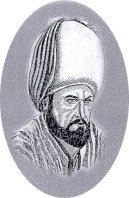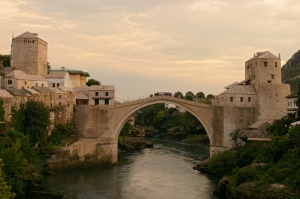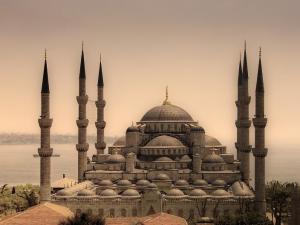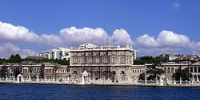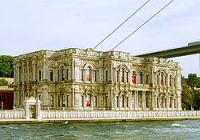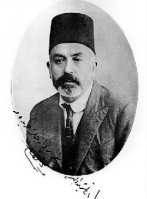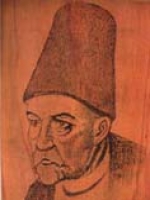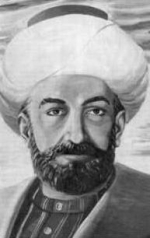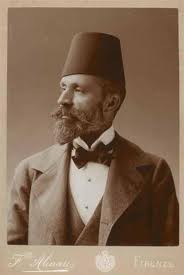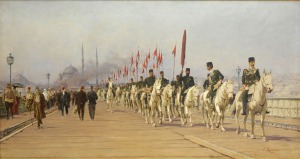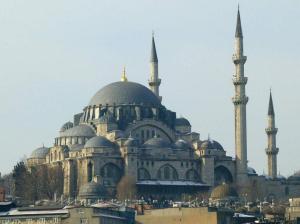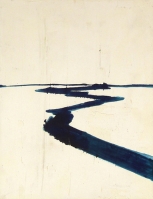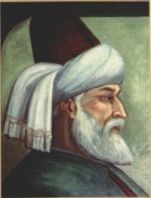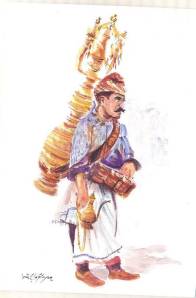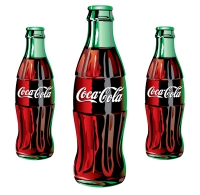#10 Levni (17 – 18th century)
He was born in Edirne, in European Turkey, some time in the late 17th century. He became the most prominent painter in Turkey, and was appointed court painter under Sultans Mustafa II and Ahmed III. He was a noted figure of the Tulip period. He died in Istanbul in 1732
As court painter he executed his marvelously composed masterpieces: the Surname-i Sultan Ahmed Han and the Surname-i Vehbi (“Book of Festival”). The latter book, still in the library of the Topkapı Palace, depicts the festivals commemorating the circumcision in 1720 of four sons of Ahmed III, However Levni’s main concern seems to have been to paint single-leaved miniatures depicting individuals: beautiful girls, languidly reclining ladies, and charming young men. The faces of his figures show little expression.
#9 Yakut el Mustafa Sami (13th century)
The inventor of Ottoman Tugra and great applicator of Hat (calligraphy) art. Unfortunately, there are many unknowns about his biography. But the beauty that he created for the emperor stayed immortal. Click here to learn basics of Ottoman tugra (Tughra).
#8 Architecture Hayreddin – Hajrudin (15-16th century)
He builds important public buildings for Sultan Beyazid II and becomes the chief architecture in the empire. It is said that his father (Murad) was also an architecture and had some important inventions in architectural designs. He is also known as one of the greatest students of (Mimar) Sinan. “Mostar bridge” can be count as one of his masterpieces. That bridge was destroyed by Serbian attack in 90s and reconstructed by the help of Unesco Nations in 2004. http://en.wikipedia.org/wiki/Mostar
#7 Architecture Sedefkar Mehmed (16th century)
He was just a garden security in 1562 when he first came to Constantinople. Then he entered the Enderun and music societies. He also became the student of (Mimar) Sinan. After his graduation as a sufist, he travelled many cities around three continent. Then he became the chief architecture in Ottoman Empire and stayed at Constantinople. He built his masterpiece in 1616: Sultan Ahmed Mosque.
#6 Balyan or Balgian Family (18 – 19th century)
For five generations in the 18th and 19th centuries, they designed and constructed numerous major buildings, including palaces, kiosks, mosques, churches and various public buildings, mostly in Constantinople. The nine well-known members of the family served six sultans in the course of almost a century and were responsible for the westernization of the architecture of the then-capital city.
Note that in historical resources, it is debated that their architectural identity may be confused with contractor or administrator identities for some members. It is unknown to define who was “architecture”, “contractor” or “administrator” among the family members. http://en.wikipedia.org/wiki/Balyan_family
#5 Mehmet Akif Ersoy (1873 – 1936)
He was a poet, author, academic, member of parliament, and the poet of the Turkish National Anthem. It is hard to say he was purely an Ottoman artist because his masterpieces mostly formed the modern Turkish nation. Basically two of them are very well known by every single Turkish citizen: National Anthem and Canakkale Sehitlerine (dedicated to Gallipoli Martyrs)
http://en.wikipedia.org/wiki/Mehmet_Akif_Ersoy
#4 Dede Efendi (1778 – 1846)
His full name is Hammamizade Ismail Dede Efendi. He composed over thousand of classical song and contributed the Ottoman music in 18th century. He invented new musical scales to play in a wide range of areas.
He was born on 9 January 1778, in Istanbul, Şehzadebaşı. He started studying music with Mehmed Emin Efendi, at the age of eight. He attended rituals at Yenikapı Mevlevihanesi, a place of Mevlevi gathering. He studied with Ali Nutki Dede and learned to play ney, in Yenikapı Mevlevihanesi. He became “Dede” in 1799. Dede Efendi’s music was well appreciated by Sultan Selim III and then he performed his works at the palace. He had composed hundreds of songs and mevlevi rituals. In 1846 he pilgrimaged to Mecca, but in Mina contracted cholera and died. His grave is now in Mecca.
Dede Efendi gave lessons in Turkish music to Hamparsum Limonciyan who developed the Hamparsum notation, the dominant notation for Turkish music.
One of the greatest Turkish composers, he has created masterpieces in all forms and modes of Turkish music. He has also developed the composite musical modes of “sultanî yegâh”, “nev-eser”, “saba-buselik”, “hicaz-buselik” and “araban kürdî”. His greatest works are the seven Mevlevi pieces for Samah. More than two hundred of his compositions are available today.
#3 B. Mustafa Itri (1640 -1712)
Many things known about him today are subject to dispute. His real name was Mustafa, and he was sometimes referred to as Buhurizade Mustafa Efendi. Itri was a major exponent of Turkish classical music. He was a very prolific composer with more than a thousand works. However, only about forty of these survived to this day.
As with most composers of his day, Itri was also a famous poet. He used poetic forms based on the classicial Ottoman school of poetry (Divan), as well as those based on syllabic meters identified with folk music and poetry. Unfortunately most of his poetry has not survived to this day. He was also known for being a calligrapher. http://en.wikipedia.org/wiki/Buhurizade_Itri
It is believed that he was a Mevlevi, and composed religious music for this order. He lived through the times of five Ottoman Sultans. He became well known during the time of Mehmet IV. He sang in fasils, which are concert programs with the same makam, in the presence of Mehmet IV. Starting from this time, he enjoyed the support of the palace for many years. He taught music in the palace Enderun school. He was also interested in gardening. It is believed that his name Itri comes from the word itir, which means pelargonium.
As with most composers of his day, Itri was also a famous poet. He used poetic forms based on the classicial Ottoman school of poetry (Divan), as well as those based on syllabic meters identified with folk music and poetry. Unfortunately most of his poetry has not survived to this day. He was also known for being a calligrapher.
Buhurizade Itri is an ancestor of the Syrian Prime Minister Muhammad Naji al-Otari.
#2 Fausto Zonaro (1854 – 1929)
In Constantinople, over time he came to the attention of the aristocratic circles, and obtained from them orders for his works.
One of these was Teşrifat Nazırı Münir Paşa who invited him to visit Yıldız Palace and meet the prestigious Ottoman artist Osman Hamdi Bey. He was then employed in teaching painting to the wife of Münir Paşa, and in this way Zonaro and his wife, got to know the important artistic figures of Constantinople of that time. In 1896 he was nominated as the court painter (Ottoman Turkish: Ressam-ı Hazret-i Şehriyari) thanks to the intervention of the Russian ambassador who had presented the ruling sultan Abdulhamid II with Zonaro’s work Il reggimento imperiale di Ertugrul sul ponte di Galata (in English: The Imperial Regiment of the Ertugrul on the Galata Bridge), which Abdulhamid II had then purchased.
This painting is of the crew of the Ottoman warship Ertugrul which had just been sent off on a visit to Japan. The Sultan later requested that Zonaro, as court painter, paint other works for him, in particular a series of paintings depicting the time of the 15th-century Ottoman sultan, Mehmed II.
The last Official Ottoman Palace artist. http://en.wikipedia.org/wiki/Fausto_Zonaro
#1 Architecture (Mimar) Sinan (16th century)
The architecture of Great Mosques in the Empire . http://en.wikipedia.org/wiki/Mimar_Sinan
